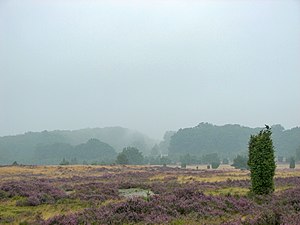Lüneburg Heath Nature Reserve
| Lüneburg Heath Nature Reserve | |
|---|---|
| Naturschutzgebiet Lüneburger Heide | |
|
IUCN category IV (habitat/species management area)
|
|

Heathland in the reserve near Niederhaverbeck
|
|
| Location | Lower Saxony |
| Area | 23.147,5 ha |
| Designation | NSG LÜ 002 |
| Established | 1921/2 |
| Administrator | NLWKN |
The Lüneburg Heath Nature Reserve (German: Naturschutzgebiet Lüneburger Heide) is one of the oldest and largest nature reserves (Naturschutzgebiete or NSGs) in Germany, and the oldest and largest in Lower Saxony. It was first established on 29 December 1921 when an area of four square miles was declared a nature park by the Prussian government.
The boundaries of the Lüneburg Heath Nature Reserve are identical with those of the Lüneburg Heath Nature Park. It lies in the northern part of the region known as the Lüneburg Heath. It is bordered to the north by Hanstedt, to the east by Egestorf, to the south by Bispingen and to the west by Schneverdingen. At the centre of the reserve is the Wilseder Berg, at 169.2 metres (555 ft) above NN the highest point on the north German plain, formed from a ridge of end moraine by the glaciers of the ice age.
Around 1900, the vast tracts of heathland were planted with forest or ploughed up for agriculture. In 1921, 21,000 hectares of the remaining heath was declared a nature reserve (the rules came into force in January 1922). In 1993 this protected area was expanded to 23,440 hectares. By the beginning of 2007 the area of the nature reserve had become identical with that of the Lüneburg Heath Nature Park. However, the latter was then further expanded on 14 February 2007 to more than 1077 square kilometres. The districts of Heidekreis and Harburg are responsible for the area in their role as subordinate nature conservation authorities.
The nature reserve comprises 60% woods, 26% heath, 8,5% cultivated land, 3% pasture, 2% marsh and 1,5% settlements, lakes, etc. There are about 5,100 hectares of dry sandy heath, the largest remaining, contiguous, inland heath of its type (a Zwergstrauchheide) in central Europe. The reserve also has extensive coniferous forests, predominantly of pine trees. These go back to the reforestation of the heathland in the 19th century. There are also small stands of older deciduous trees: oaks and beech. The high proportion of woods makes the Lüneburg Heath Nature Reserve one of the largest areas of protected woodland in Germany. In addition there are streams and small valleys, marshes, meadows, pastures, fields and open sands.
...
Wikipedia

